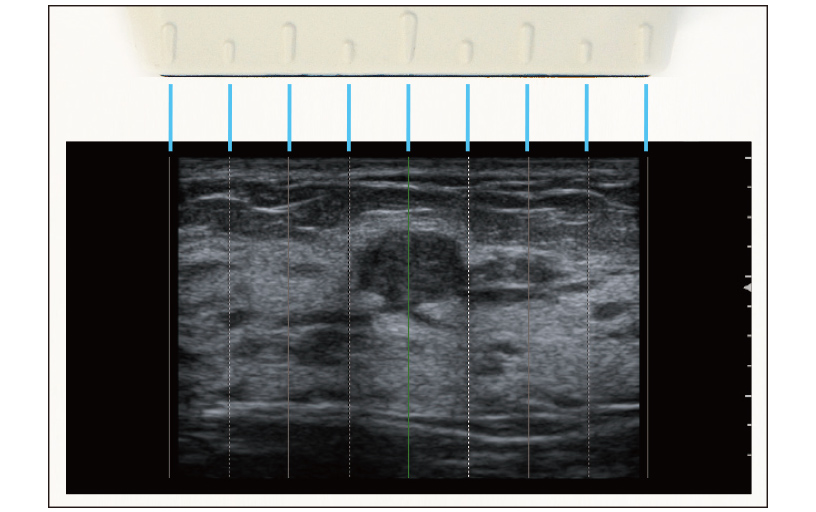The content on this page is intended to healthcare professionals and equivalents.
Tools for diverse clinical uses and detailed evaluation
RADIOLOGY

Real-time Tissue Elastography (RTE)*1
Assesses tissue strain in real time and displays the measured differences in tissue stiffness as a color map. Its application has been validated in a wide variety of clinical fields: for the breast, thyroid gland and urinary structures. Using the abdominal convex transducer, it can also provide an estimation of liver fibrosis staging in patients with hepatitis C (LF Index)*1.
HI Strain

HI Strain is an algorithm used to display an Elastography image more consistently than before. It is possible to display Elastography images with high continuity while maintaining temporal resolution and spatial resolution.
Auto Frame Selection (AFS) / Assist Strain Ratio (ASR)

Auto Frame Selection (AFS) picks out the appropriate frame for measurement in RTE. Assist Strain Ratio (ASR) automatically locates the measurement ROI in Fat Lesion Ratio (FLR)*2 measurement. Measurements can be performed more quickly and easily.
- *2 FLR = Fat/Lesion Ratio of lesion to subcutaneous fat strain
Needle Emphasis (NE)

Automatically adjusts the deflection angle of beams and images to enhance needle visibility and assist in safe and accurate punctures.
Marking Assist

Lines displayed in B-mode imaging correspond to markers on the transducer head.
Contrast Harmonic Imaging (CHI)*1
Widely-used imaging technique that provides homogeneous enhancement throughout the field of view to enhance diagnostic capability.
Transrectal Transducer
It is possible to display short and long axis images of the prostate side by side in real time.
A wide range observation can be achieved with a viewing angle of 180 degrees (200 degrees with Wide Scanning).


Courtesy of : Dr. Sunao Shoji, Department of Urology, Tokai University School of Medicine
SURGERY
Intraoperative Transducers
Versatile transducers are prepared by application: a convex transducer held between users’ fingers, a laparoscopic transducer held with forceps.

- *3 CHI compatible intraoperative transducers
Contrast Harmonic Imaging (CHI)*1
Some transducers support intraoperative contrast-enhanced ultrasound, which is useful to detect a lesion and secure a resection margin in surgical operations.
WOMEN’S HEALTH

3D/4D *1
3D/4D images play an active role as a communication tool to make the mother feel close to the baby. The 4D shading technology gives a more realistic appearance to the rendered surface of the fetus, and delineates clear 3D/4D images.
Auto EFW *1

By analyzing the characteristics of the target and providing automatic setting of the measurement point, Auto EFW (Estimated Fetal Weight) facilitates measurement of one of the parameters for fetal growth evaluation.
CARDIOVASCULAR
Cardiac Functions
Equipped with automated tools for a faster and smoother cardiovascular examination, built on data acquired by our premium systems.
Automated ED/ES Detection

Automatically displays ED and ES frames in split screen view.
Automated Sample Gate Alignment

Automatically sets the cursor position of the sample volume gate.
Automated Measurements*1

Automatically measures values used in calculations to assess cardiac function, such as EF.
Dual Gate Doppler

Makes it possible to observe Doppler waveforms from two locations simultaneously. This enables LV diastolic performance indicators, such as the E/e' Ratio, to be measured during the same heartbeat.
Global Longitudinal Strain (GLS)

Recent interest has been shown in the GLS, the ratio of change in LV endocardium length, which can be altered significantly in patients with heart failure even when a normal Ejection Fraction (EF) is maintained.
2D Tissue Tracking (2DTT) *1

Speckle tracking technique that quantifies and analyzes movement of the entire left ventricle or local movement of the myocardium.
Auto IMT *1

Automatically measures the Intima-Media Thickness (IMT) following the placement of an ROI on the long axis view of the carotid artery.
- *1 The standard components and optional items differ depending on the country
- *2 FLR = Fat/Lesion Ratio of lesion to subcutaneous fat strain
- *3 CHI compatible intraoperative transducers




















